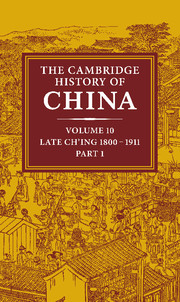Book contents
- Frontmatter
- 1 Introduction: the old order
- 2 Ch'ing Inner Asia c. 1800
- 3 Dynastic decline and the roots of rebellion
- 4 The Canton trade and the Opium War
- 5 The creation of the treaty system
- 6 The Taiping Rebellion
- 7 Sino-Russian relations, 1800–62
- 8 The heyday of the Ch'ing order in Mongolia, Sinkiang and Tibet
- 9 The Ch'ing Restoration
- 10 Self-strengthening: the pursuit of Western technology
- 11 Christian missions and their impact to 1900
- Bibliographical essays
- Bibliography
- Genealogical chart
- Glossary
- Index
- References
8 - The heyday of the Ch'ing order in Mongolia, Sinkiang and Tibet
Published online by Cambridge University Press: 28 March 2008
- Frontmatter
- 1 Introduction: the old order
- 2 Ch'ing Inner Asia c. 1800
- 3 Dynastic decline and the roots of rebellion
- 4 The Canton trade and the Opium War
- 5 The creation of the treaty system
- 6 The Taiping Rebellion
- 7 Sino-Russian relations, 1800–62
- 8 The heyday of the Ch'ing order in Mongolia, Sinkiang and Tibet
- 9 The Ch'ing Restoration
- 10 Self-strengthening: the pursuit of Western technology
- 11 Christian missions and their impact to 1900
- Bibliographical essays
- Bibliography
- Genealogical chart
- Glossary
- Index
- References
Summary
Historians have tended to view the Ch'ing empire's nineteenth-century history as a period of decline. Europeans took concessions and territory. Rebels shattered the peace within. But in the 1800s the Ch'ing empire and China were not yet fully one. If the empire as such was in decline, China, the Han Chinese, their culture and their power, were beginning a period of unprecedented expansion. China had assimilated her Manchu conquerors. To survive the rebellions, the dynasty was forced to break the Manchu bannermen's monopoly of military might and put the command of armies into Han Chinese hands.
In Inner Asia, the first half of the nineteenth century witnessed the heyday of the Ch'ing order. Here the empire consolidated its earlier military gains, and only in Altishahr did this mean the repeated use of arms. Population pressure in China proper and Han Chinese trade initiatives eroded the dynasty's policy of segregating China from Inner Asia. The erosion was an expression of growing Han Chinese strength. The government had made the first official exceptions to its policy in the 1700s with the colonization of Tsinghai and Zungharia. Gradually it relaxed its efforts to seal off Mongolia and the Manchurian frontier. Segregation came more and more under attack. The ‘statecraft’ scholars Kung Tzu-chen and Wei Yüan both called for the fuller use of Sinkiang to provide land for China's landless Han population. Growing numbers of Han Chinese made their way into Ch'ing Inner Asia, even into strictly closed areas like Heilungkiang and Altishahr. Only central Tibet – remote and uninviting to Chinese settlement – remained untouched by the crescendo of sinicization and Han immigration.
- Type
- Chapter
- Information
- The Cambridge History of China , pp. 351 - 408Publisher: Cambridge University PressPrint publication year: 1978
References
- 13
- Cited by



